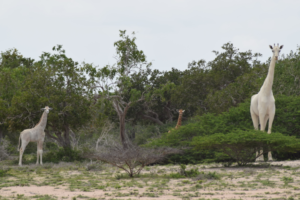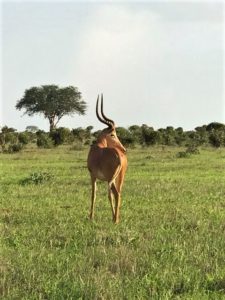The reports had been coming in for some time—a pair of white giraffes, a female and cub, were roaming around the northeastern Kenyan countryside near the Ishaqbini Hirola Conservancy. On August 2, 2017, wildlife rangers finally filmed the pair, confirming the existence of the rare animals. Soon thereafter, the video went viral!
The pair are reticulated giraffes, found throughout southern and eastern Africa. They are not albinos, but rather have a condition known as leucism, which prevents pigments from forming in skin tissue. Pigments are formed in other tissues, however, so that the animals eyes, horns, hooves and other features are colored normally (albino animals normally have red eyes). Leucism occurs in many vertebrates, including not only mammals, but also birds, fish and reptiles.

Although leucistic giraffes are rare, sightings have been reported as far back as 1912, with other reports sprinkled in the 1930s and 1950s. In 2016, white giraffes were reported in Tarangire National Park in Tanzania. Leucism is genetic, so the animals are white or only lightly colored from birth, but a condition of progressive loss of pigment has also recently been reported in Kenya.
Giraffes, whether white or not, are among the most popular of the great African mammalian fauna. The giraffe is the tallest land animal on earth, able to graze at heights beyond the reach of other animals. The IUCN considers all giraffes to be of one species (Giraffa camelopardalis), but recognizes nine subspecies. The species is considered “vulnerable” by IUCN, because numbers have been declining steadily over the past 30 years. About 100,000 giraffes live in Africa, down from 150,000 in 1985. The major cause of population decline is habitat loss, as forests are converted to farmland and as other land uses, including mining and urbanization, make habitat unsuitable. The species is also impacted by armed conflicts and illegal hunting.
Aside from white giraffes, the area is most known as the remaining habitat for the hirola (Beatragus hunteri), an antelope endemic to southeastern Kenya and southwestern Somalia. The species, also known as Hunter’s antelope, is considered “critically endangered” by IUCN, with the adult population numbering around 250 individuals. The Hirola Conservation Programme began in 2005 to preserve the hirola and to improve the living conditions for local people that share the hirola’s habitat, recognizing “that conservation is a multi-stakeholder initiative and does not occur in isolation.”

Dr. Abdullahi Ali, founder and director of the Hirola Conservation Programme, said about the discovery of the leucistic giraffes, “Nature is always stunning and continue[s] to surprise humanity! These rare snow white giraffes shocked many locals including myself but these gave us renewed energy to protect and save our unique wildlife.”
Lest we think that we’ve got nature all figured out, think about these white giraffes—and think again!
References:
Hirola Conservation Programme. 1917. Anoter White (Leucistic) Giraffe Sighting in the Hirola’s Range. Available at: http://www.hirolaconservation.org/index.php/component/k2/item/24-another-white-leucistic-giraffe-sighting-in-the-hirola-s-range. Accessed June 4, 2018.
Joseph, Yonette. 2017. Rare White Giraffes Cause a Stir in Kenya. The New York Times, Sept. 16, 2017. Available at: https://www.nytimes.com/2017/09/16/world/africa/rare-white-giraffe-kenya.html. Accessed June 4, 2018.
Muller, Zoe. 2016. White giraffes: The first record of vitiligo in a wild adult giraffe. African Journal of Ecology 55(1):118-0123. Accessed June 4, 2018.
